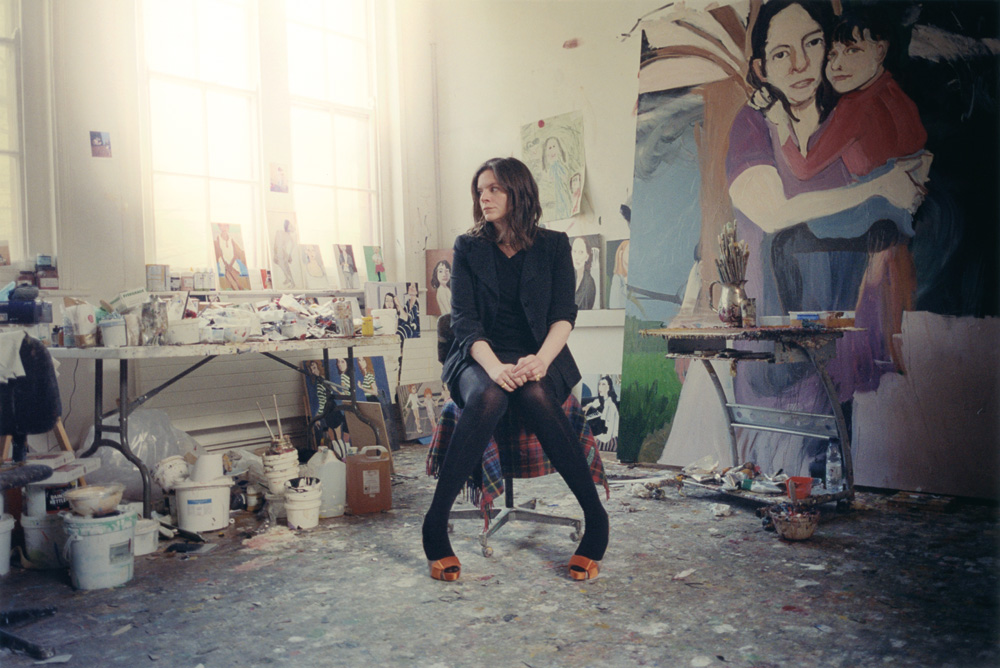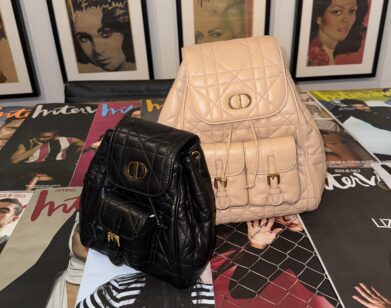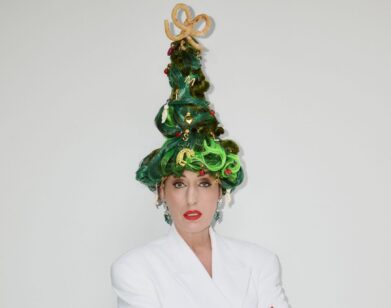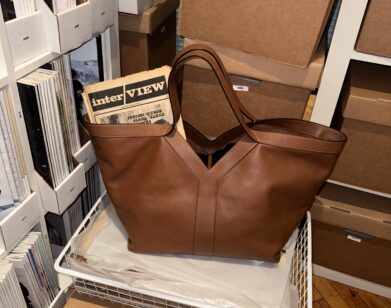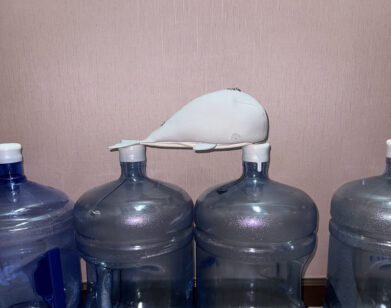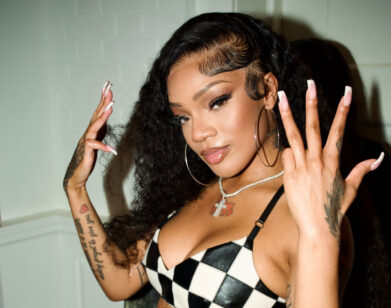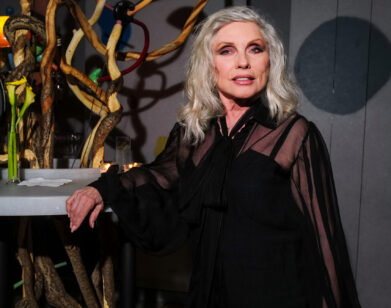Chantal Joffe
Women, children, and fashion—on paper, Chantal Joffe’s interests seem prettyquotidian. But on canvas, where the 39-year-old artist paints shots ripped from fashion magazines or photographs of friends holding their babies, the feminine world suddenly becomes a dark, loaded, highly sexualized place. Joffe is not a realist. She distorts the women in her frames for ultimate psychological effect. But the subjects rarely seem like victims, even if the brushstrokes are hard and unforgiving. It turns out, Joffe is actually a massive fan of fashion and sees what she does as high celebration. She paints models like Freja Beha, Kate Moss, and Lara Stone because they seem to her like storybook characters come to life. Recently, Joffe even collaborated with fashion photographer Miles Aldridge, painting his wife, model Kristen McMenamy, in Joffe’s studio, while Aldridge shot film. This painting was included in the artist’s most recent solo show, in New York this spring at Cheim & Read gallery. The love of the fashion industry has proven reciprocal. Stella McCartney is one designer who collects Joffe’s work. In fact, Joffe has painted all three of McCartney’s children (the paintings hang in the Stella McCartney store in London) and even shot models backstage at McCartney’s Fall 2009 show in Paris. The two friends caught up to discuss, among other things, why the weird models are always the sexiest.
STELLA MCCARTNEY: It’s obvious that a lot of your paintings are based on fashion photography. But when I spoke to you at Christmas, you were too scared to go into my shop. So what exactly is the deal here? What’s your take on all of this?
CHANTAL JOFFE: Well, I like the stories. I like the narratives that you get in fashion photography. And I like what the clothes do to the body—the patterns and stripes and all of that.
MCCARTNEY: So it’s not a reaction against the industry?
JOFFE: No.
MCCARTNEY: Because it doesn’t look like one. It looks to me like a celebration of the female form—and that in itself is a connection with fashion.
JOFFE: I don’t know where else I would find all of those images of women. And I actually love specific models as well. It’s funny, I’ve been painting Freja a lot.
MCCARTNEY: So you saw her at my show then?
JOFFE: Yeah, it was like meeting somebody out of a book. I mean, I didn’t talk to her, and I didn’t really want to. She’s such an odd character.
MCCARTNEY: Why didn’t you want to talk to her?
JOFFE: I thought she might think I was creepy, more than anything else. [both laugh] But I like the weird ones. I like the girls who are a little odd.MCCARTNEY: But what’s interesting is that you could easily have taken photos of these girls yourself. Instead you remain a viewer of magazines and advertisements—and create some sort of double take. Like, I’m looking at this painting you did of Kate Moss, which is from an ad campaign. So I’m already familiar with the image, and then I come to your painting to see your spin on it.
JOFFE: When you’re looking through a magazine, what makes you stop and think is when you see an image and imagine the narrative that is going on inside of it. Those are the ones I make into paintings.
MCCARTNEY: What artists have inspired you?
JOFFE: I find photography massively influential. Specifically, Diane Arbus, who I’ve been obsessed with my whole life. Her work has everything about the portrait of a human that you can ever want. Although her work is pretty depressing stuff . . .
MCCARTNEY: So do you want to do photos as well as paint?
JOFFE: No, I’m a terrible photographer.
MCCARTNEY: And yet you also paint from your photos—and your paintings are incredible, so your pictures must be good.
JOFFE: I’m not being modest. They really are crap. But in a way, the more the photo is crap, the better to paint from. [laughs] Like, for the ones of me and my daughter—the more awkward and bad the photo, the better the painting turns out. Do you know the photographs of Harry Callahan? The ones he shot of his wife are highly formal, but they are also incredibly intimate. That was a really profound influence for me in trying to make paintings of me and my daughter. How can you make a great painting that is also of the most intimate thing?
MCCARTNEY: I know you have a show this spring in New York. You haven’t had your paintings shown there in a while. Was that intentional?
JOFFE: Nobody asked me. [laughs]
MCCARTNEY: Why do you mainly paint women?
JOFFE: Right—“Why are there no men?” It’s because I think about women and their thoughts and ideas, and I suppose when I’m painting them I’m getting to be them, in a sense.
MCCARTNEY: You can relate to them.
JOFFE: Yeah, it’s as simple as that. I really love painting women. Their bodies, their clothes—it all interests me, whereas men really don’t that much, in a way.
MCCARTNEY: I guess you’re in good company. Most male painters have historically admired the female form. It’s got a lot going for it.
JOFFE: I wanted to ask you a question.
MCCARTNEY: But, I’m interviewing you.
JOFFE: I know, but at your last show in Paris I noticed that all of the models looked like you. I thought that was rather interesting . . . It’s a bit like how I paint women in a way—a sort of projection of your own personality onto them.
MCCARTNEY: I think when you’re a woman designer who designs for women, that’s kind of unavoidable. It’s actually the big perk of the job. I remember years ago I asked Marc Jacobs how he designed for women, because for me it comes naturally, because I am a woman. He said, “Oh, I just think, if I were a woman, what would I want?” That seems like such a complicated process every time you want to design a shoe or a jacket.
JOFFE: Do you pick the models for your show?
MCCARTNEY: I choose them. I have a guy who does casting for me, but we work together. It’s funny, because whenever someone else is excited about a girl who I am not keen on and I eventually give in, I always regret it when I see her on the runway. “Ugh, I knew I didn’t like her. She’s just not very me.” I think it took me a little while to be true to myself as a designer, and in some ways I’m still trying to do that. I have to choose things that come naturally to me. Whenever I challenge something too much or try too hard, it never quite works out.
JOFFE: It was fascinating to be backstage, because I’m interested in the models as specific people. And when I see you and your relationship with them at the show, it adds a degree of complexity.
MCCARTNEY: It made perfect sense to have you there, because I’ve known you for a while now and I have this access to these bloody great models!
JOFFE: You had Lara Stone backstage. She’s brilliant—and so awkward on the runway, it’s fantastic! I love that. Hugging her tits in this kind of slightly embarrassed way. I thought it was brilliant.MCCARTNEY: It’s rare that someone paints in celebration of the fashion industry without there being some kind of underlying negativity. I’m coming back to Lara because she has these fantastic breasts. A lot of designers don’t use her because she is too big for them. For me, I want to celebrate Lara. I’m like, “Put her in the tightest dress and get her down there.” She’s more of an editorial model than a runway model. But the fact that she comes across as awkward is a lot sexier to me. She’s about as sexy as it gets.
JOFFE: Yeah.
MCCARTNEY: You and I both live in Britain, and are of a certain generation that has seen the whole Brit-art thing happen. During that time, painting almost seemed to get lost along the way. But you are a real painter. Have you always only painted in your specific style?
JOFFE: Yes. [laughs] I went to Glasgow School of Art in 1988 because they still had figure painting, where you painted from life. I suppose all along all I ever really wanted to do was paint people. That never changed.
MCCARTNEY: You’ve painted all three of my children, and those pieces are exquisite.
JOFFE: I’m almost weeping when I’m painting my daughter. I’ve been thinking she won’t be little for much longer.
MCCARTNEY: When are you going to New York?
JOFFE: The show is in May, but I have to leave a long time before that because I’m going by boat. I don’t fly. [McCartney gasps] It makes me feel really immobile but great.
MCCARTNEY: Wow, you and David Bowie. What do you mean, you don’t fly? Why don’t you fly? Is that for environmental reasons?
JOFFE: I wish it were.
MCCARTNEY: Is it because you’re scared of flying?
JOFFE: Yeah, that’s the sad, true reason. So we go by boat, which isn’t bad.
MCCARTNEY: Do you go on the QE2 or something?
JOFFE: The Queen Mary 2 now—it takes six days. I went on a freighter before, but my daughter’s not allowed to ride on those. I get quite seasick. I mean . . . [laughs] It’s not that great.
MCCARTNEY: Well, I love your paintings. I have them hanging in my shop. They fit perfectly. It’s really difficult to choose art when you start your business.
JOFFE: I can imagine. You had a really wonderful backdrop for your last show.
MCCARTNEY: That was a Sam Taylor-Wood photograph, and Dino Chapman painted in the sky. It was very last-minute. I called up Sam and said, “Can I use one of your photos?” She said, “Yep.” So I called up Dino and said, “Could you fuck it up a bit?” He said, “Yep.” I’m very lucky, actually. I might call you up one day. How long would it take you to paint a backdrop for me?
JOFFE: Quite some time at that size.
MCCARTNEY: Then I’ll call you up for Spring/Summer 2020. You can start working on it now.
JOFFE: It struck me when I came over to your house that you have three children. Really, women and children are my main subjects. But I was amazed that you do what you do and raise three kids.
MCCARTNEY: It’s not a feminist issue. It’s pretty extraordinary for any human being to work and have three kids under the age of 5.
JOFFE: But when I was there, it struck me that it is a feminist thing—women’s lives are so elaborately complicated.
MCCARTNEY: And yet you paint these lovely, young women who just come across as perfection. You paint perfection sometimes, don’t you? When you think of fashion photography, it’s a dream. It’s like we all want to be those women. We want to wear those dresses.
JOFFE: I don’t think I do want to be them. I’m fascinated to imagine what their lives are like, but I certainly wouldn’t want to be them.
MCCARTNEY: I don’t think their lives are anywhere near as glamorous as you think.
JOFFE: It just fascinates me to be only 18 and to have that life.
MCCARTNEY: Eighteen! They’re old if they’re 18 in this day and age.
JOFFE: Right. But still I’m interested in the sheer fascination of beauty—beauty is fascinating.
Stella McCartney is a U.K.–based fashion designer.
View more work at the Saatchi Gallery Web site.

